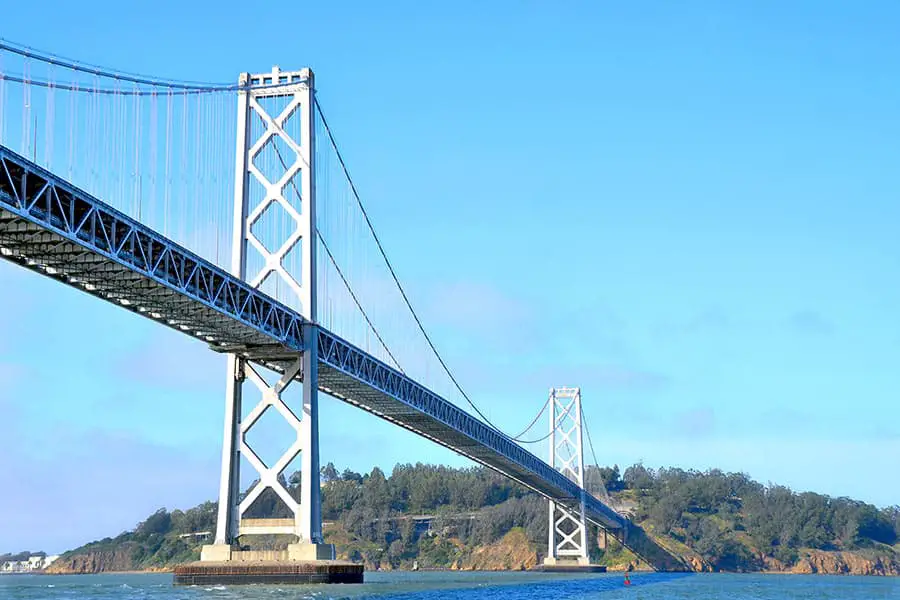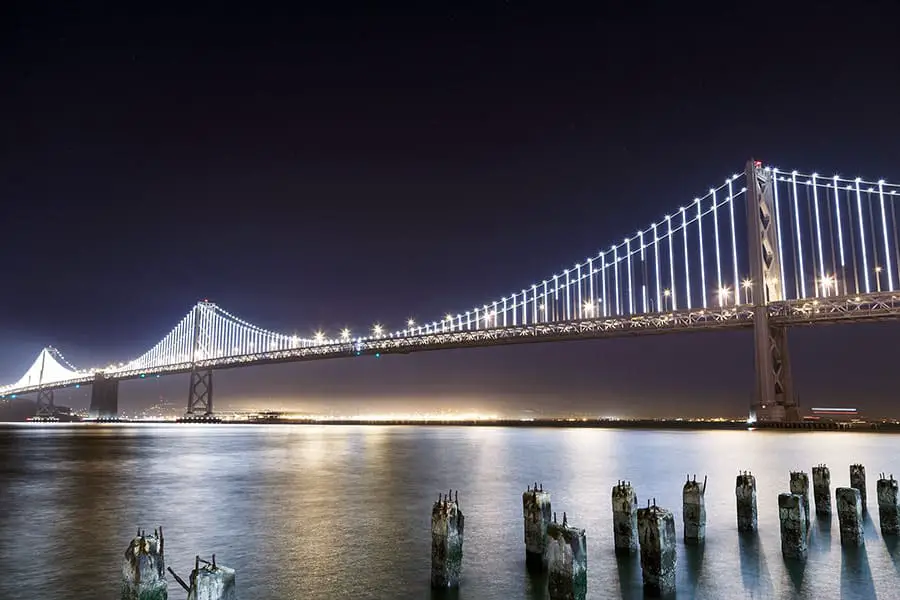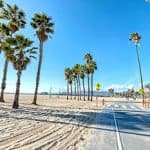
San Francisco’s location is unique. Situated on a peninsula surrounded by the gorgeous Pacific Ocean and the San Francisco Bay, it was easily defendable in its early days. Unfortunately, with modernization came new challenges. The only way to access the city without traveling around the bay was by boat. This lack of convenience created the need for several impressive bridges to be built. So, which was built first, the Golden Gate Bridge or the Bay Bridge?
The Golden Gate Bridge began construction before the Bay Bridge, and the two were worked on simultaneously by thousands of workers. Despite the early start, the Bay Bridge completed construction five months ahead of the Golden Gate Bridge.
San Francisco’s waterfronts would be bare without its famous bridges. If you are interested in architecture, engineering, or just California history, these can be a great addition to any visitor’s itinerary. Continue reading for the history of the bridges’ construction, unique features, and hazards that have occurred over the decades.
Golden Gate or Oakland Bay Bridge – Which was Built First?
The year 1933 was a big year for bridge construction in the San Francisco Bay Area. The local government realized that there was a need for an easy way for people to cross the San Francisco Bay. So, on January 5th, construction began on the Golden Gate Bridge.
A few months later that year, construction began on the Bay Bridge on July 8th. Unfortunately, the Bay Bridge construction was delayed due to 12 enormous underwater telephone cables that needed to be moved.
Although the Golden Gate Bridge construction started earlier, the Bay Bridge was completed first on November 12, 1936, and opened for travel that same day. The Golden Gate was completed five months later, on April 19, 1937, but didn’t open for traffic until May 27th.
Brief History of the Golden Gate Bridge
Before the Golden Gate Bridge was completed, the only way for people to get from San Francisco to Marin County was by boat. An official ferry service began in 1820. While a bridge made logical sense, many didn’t think that building a bridge that long was possible.

The bridge would also have to withstand many other natural oppositions. For example, there was uncertainty about the impacts of earthquakes, winds, and fog.
People were also concerned that a bridge would interfere with ship traffic (although most of this opposition came from the Southern Pacific Railroad, which benefited from shipping things by boat across the bay).
One of the key supporters of the bridge was the auto industry which was growing and required an increase of roads and bridges.
In 1924, a hearing was held, and approval to transfer federal land for the construction of the bridge was granted. As a consequence, the Golden Gate Bridge was constructed to carry US Route 101 and California State Route 1. The bridge would also allow pedestrian and bicycle traffic during selected hours.
Brief History of the Bay Bridge
After the transcontinental railroad project was completed in 1869, it couldn’t reach San Francisco because of the bay. Since the Gold Rush days, many people dreamed of building a bridge that contained rail lines. In 1872, the Bay Bridge Committee was formed to come up with plans to build the bridge.
Self-proclaimed “Emperor” Joshua Abraham Norton suggested that a suspension bridge should connect Oakland with San Francisco, and much of the public approved of his idea. But unfortunately, the bay was too wide and too deep for this endeavor, so Norton died not seeing his vision come to fruition.

The idea, however, did not die, and in 1929 the Hoover-Young Commission was appointed to collect ideas and designs for such a bridge. The route would need to include the Yerba Buena Island to make building the bridge possible. Approval was required from the U.S. Congress because Yerba Buena Island was a U.S. Navy base.
The Bay Bridge ended up being a combination of link structures, including a tunnel, two double-checked suspension spans, a center anchorage, and a transition span.
Other Posts of Interest
- What Is The Purpose Of Coit Tower?
- What Is The Presidio In San Francisco?
- What Is John Muir Known For?
- Is It More Expensive To Live In San Francisco Or Los Angeles?
Workforce and Costs of the Bridges
The Golden Gate Bridge cost roughly $76 million to construct and required several thousand workers. In the end, the bridge, which was built of steel, stretched an impressive 1.7 miles standing 746 feet tall and 90 feet wide. Each day, approximately 110,000 vehicles cross the Golden Gate Bridge.
The Bay Bridge cost a similar amount at $77 million, with over 8,000 workers dedicated to the project. The Bay Bridge, a combination of steel and concrete structures stretches 8.4 miles, including the toll plaza and approaches, stands at 526 feet tall and is 15 traffic lanes wide to accommodate the daily traffic of approximately 247,720 vehicles.
Bay Area Answers Fun Fact: Upon construction, the Golden Gate Bridge was the longest suspension bridge in the world. The bridge held the record for over 25 years until it was surpassed in 1964.
Why Did the Bay Bridge Collapse in 1989?
On October 17, 1989, the Loma Prieta earthquake rattled the San Francisco Bay area. This earthquake was measured at a magnitude of 6.9 and caused widespread damage. During the earthquake, a 76-foot by 50-foot section of the upper deck of the Bay Bridge fell on the deck below. This damage was a result of bolts that broke when the bridge shifted 7 inches to the east.
Caltrans (California Department of Transportation) was responsible for the removal of the debris and replacing the damaged section. Repairs were made quickly, and the bridge re-opened on November 18th.
It was apparent after the earthquake that the bridge needed some additional repair and upkeep for the long-term safety of the structure. The most cost-effective plan was to build a new bridge. In January of 2002, construction began to replace the eastern span. The project wasn’t completed until 11 years later at the cost of approximately $6.4 billion.
Is the Old Bay Bridge Still in Use?
After the current Bay Bridge was built, there was no longer a need for the old Bay Bridge. Within a year, demolition of the old east span was complete erasing the landmark that had graced the San Francisco Bay for over 80 years.
Following the demolition of the old Bay Bridge, the only remaining elements were six large concrete piles that once served as a part of the foundation. The city had initially planned to demolish these piles. The cost for the project was expected to be between $40 to $60 million.
For the same price, the city could create a new park, Judge John Sutter Regional Shoreline, which features a 600-foot observation pier built on top of the piles. The park, located on the Oakland side of the Bay Bridge, has walking paths, interpretive panels, and places to sit to relax and take in views of the bay.
Does the Bay Bridge Light Up at Night?
Light artist Leo Villareal created The Bay Lights to celebrate the 75th anniversary of the San Francisco-Oakland Bay Bridge. The light display on the Bay Bridge includes 25,000 individual white LED lights that are connected to the cables on the 1.8 miles section of the suspension bridge between Yerba Buena Island and San Francisco (western span only).

Originally this was to be a temporary 2-year installation (March 5, 2013, to March 5, 2015). The total cost of the initial project was $8 million. The lights were re-installed at the beginning of 2016 and became a permanent fixture. The display is illuminated every day from dusk to dawn.
Since the lights are only mounted on the bridge’s west span, the best place to view The Bay Lights is one of the public piers along the Embarcadero. This area is easily accessible for visitors staying in Union Square or Fisherman’s Wharf.
What Color is the San Francisco-Oakland Bay Bridge?
The architect who designed the Bay Bridge was inspired by the massive white container cranes in the nearby Port of Oakland.
The white finish creates a stark contrast to the surrounding water making the Bay Bridge visible for miles. Unfortunately, this finish requires constant upkeep and is continuously being repainted section by section.
Visiting the Famous Bridges of San Francisco
While the Golden Gate Bridge is the most recognizable icon of San Francisco, both the Golden Gate Bridge and Bay Bridge are engineering marvels that can be a great addition to any itinerary. The best factor is that both of these impressive structures are easily accessible from downtown San Francisco via public transportation. You can also get great views of these bridges from the water.





